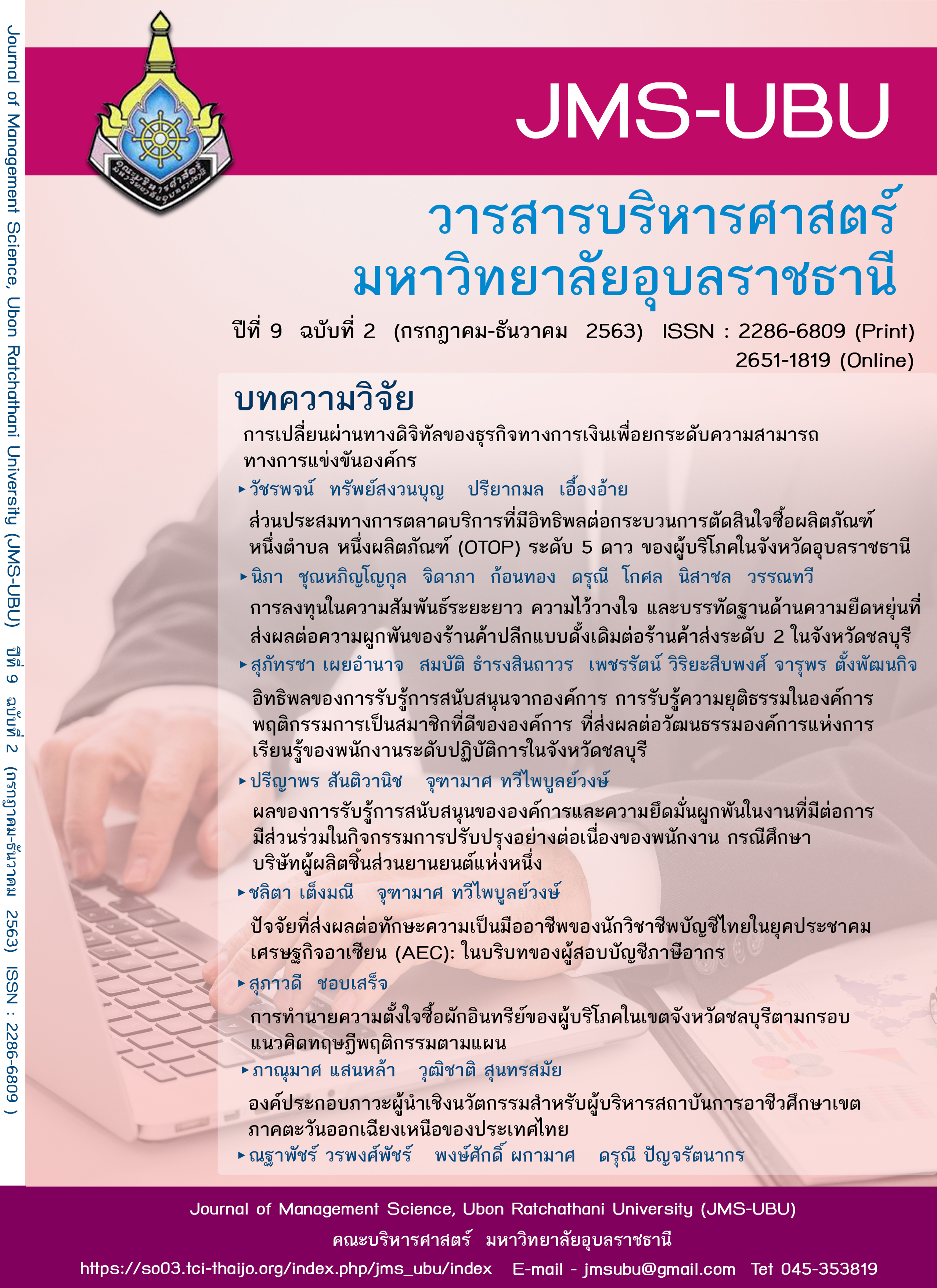Factors Influencing the Professional Skills of Thai Professional Accountant in the ASEAN Economic Community (AEC): in the Context of Tax Auditors
Main Article Content
Abstract
The objective of this research was to study on the factors affecting the Professional Skills of Thai Accounting Professional in the ASEAN Economic Community (AEC): in the context of Tax Auditors. This research specifically examined Tax Auditors in Thailand and gathered data from the sample drawn from the Revenue Department data based online. The questionnaire was used as data collection instrument. There are 179 returned questionnaires used in this analysis and multiple regression analysis was employ to test the postulated hypotheses. The results demonstrate that audit learning competency, audit experience, and continuous professional development have a significant positive effect on professional skills. The received finding can be applied for developing ASEAN professional accountants having more professional skills.
Downloads
Article Details
References
จินตนา ชัยยวรรณาการ. (2555). ก้าวที่สำคัญของนักบัญชีเข้าสู่ AEC. กรมเจรจาการค้าระหว่างประเทศ. กรุงเทพฯ.
เฉลิมขวัญ ครุธบุญยงค์. (2556). คุณสมบัติของนักบัญชีที่พึงประสงค์สำหรับอุตสาหกรรมญี่ปุ่นในประเทศไทย(รายงานวิจัย). สถาบันเทคโนโลยีไทย-ญี่ปุ่น.
ณัฎฐธิดา จินมอญ. (2559). ความเป็นมืออาชีพกับคุณภาพการสอบบัญชีของผู้สอบบัญชีรับอนุญาตแห่งประเทศไทย. (วิทยานิพนธ์ปริญญามหาบัณฑิต). มหาวิทยาลัยราชภัฏเชียงราย, สาขาวิชาการบัญชี.
ณัฐชา วัฒนวิไล และจุฑามน สิทธิผลวนิชกุล. (2555). การพัฒนาศักยภาพวิชาชีพบัญชีไทยเมื่อเปิดเสรีทางเศรษฐกิจ. วารสารนักบริหาร, 32(3), 16-25.
นันทวรรณ วงค์ไชย. (2552). ผลกระทบของความเป็นมืออาชีพและจรรยาบรรณวิชาชีพที่มีต่อคุณภาพการสอบบัญชีของผู้สอบบัญชีรับอนุญาตในเขตกรุงเทพมหานคร. (วิทยานิพนธ์ปริญญามหาบัณฑิต). มหาวิทยาลัยมหาสารคาม, ภาควิชาการบัญชี.
สงกรานต์ ไกยวงษ์. (2553). ปัจจัยที่ส่งผลต่อทักษะความเป็นมืออาชีพของผู้สอบบัญชีภาษีอากรและผู้สอบ
บัญชีรับอนุญาต. วารสารสุทธิปริทัศน์, 23(72), 34-52.
สภาวิชาชีพบัญชี ในพระบรมราชูปถัมภ์. (2559 ก). มาตรฐานการศึกษาระหว่างประเทศสำหรับผู้ประกอบวิชาชีพบัญชี
ฉบับที่ 1 เรื่อง ข้อกำหนดเพื่อเข้าสู่โปรแกรมการศึกษาทางวิชาชีพบัญชี. สืบค้นเมื่อ 3 มกราคม 2559,
จาก http://fap.or.th.a33.readyplanet.net/images/column_1359010350/1.pdf
สภาวิชาชีพบัญชี ในพระบรมราชูปถัมภ์. (2559 ข). มาตรฐานการศึกษาระหว่างประเทศสำหรับผู้ประกอบวิชาชีพบัญชี
ฉบับที่ 2 เรื่อง เนื้อหาของโปรแกรมการศึกษาทางวิชาชีพบัญชี. สืบค้นเมื่อ 3 มกราคม 2559,
จาก http://fap.or.th.a33.readyplanet.net/images/column_1359010350/2.pdf
สภาวิชาชีพบัญชี ในพระบรมราชูปถัมภ์. (2559 ค). มาตรฐานการศึกษาระหว่างประเทศสำหรับผู้ประกอบวิชาชีพบัญชี
ฉบับที่ 3 เรื่อง ทักษะทางวิชาชีพ. สืบค้นเมื่อ 3 มกราคม 2559,
จาก http://fap.or.th.a33.readyplanet.net/images/column_1359010350/3.pdf
สภาวิชาชีพบัญชี ในพระบรมราชูปถัมภ์. (2559 ง). มาตรฐานการศึกษาระหว่างประเทศสำหรับผู้ประกอบวิชาชีพบัญชี
ฉบับที่ 5 เรื่อง ข้อกำหนดด้านประสบการณ์ทำงานจริง. สืบค้นเมื่อ 3 มกราคม 2559,
จาก http://fap.or.th.a33.readyplanet.net/images/column_1359010350/5.pdf
สภาวิชาชีพบัญชีในพระบรมราชูปถัมภ์. (2559 จ). มาตรฐานการศึกษาระหว่างประเทศสำหรับผู้ประกอบวิชาชีพบัญชี
ฉบับที่ 7 เรื่อง การพัฒนาทางวิชาชีพอย่างต่อเนื่องเกี่ยวกับโปรแกรมเพื่อการเรียนรู้ตลอดชีวิต.
สืบค้นเมื่อ 3 มกราคม 2559,
จาก http://fap.or.th.a33.readyplanet.net/images/column_1359010350/7.pdf
Arel, B. (2010). The influence of litigation risk and internal audit source on reliance decisions. Advances in Accounting, 26(2), 170-176.
Bedard, J. C., Graham, L., & Jackson, C. (2005). Information systems risk and audit planning. International Journal of Auditing, 9(2), 147-163.
Carnaghan, C. (2006). Business process modeling approaches in the context of process level audit risk assessment: An analysis and comparison. International Journal of Accounting Information Systems, 7(2), 170-204.
Garcia-Benau, M. A. & Zorio, A. (2004). Audit reports on financial statements prepared according to IASB standards: Empirical evidence from the European Union. International Journal of Auditing, 8(3), 237-252.
Hair, J. F. Jr., Black, W. C., Babin, B. J., Anderson, R. E. & Tatham, R.L. (2010). Multivariate Data Analysis. 6thed. New Jersey: Pearson Education International.
Haurani, M. J., Rubinfeld, I., Rao, S., Beaubien, J., Musial, J. L., Parker, A., . . . Shepard, A. (2007). Are the communication and professionalism competencies the new critical values in a resident’s global evaluation process?. Journal of Surgical Education, 64(6), 351-356.
Havelka, D., & Merhout, J. W. (2013). Internal information technology audit process quality: Theory development using structured group processes. International Journal of Accounting Information Systems, 14(3), 165-192.
Krejcie, R. V., & Morgan, D. W. (1970). Determining sample size for research activities. Educational and Psychological Measurement, 30, 607-610.
Kutner, M., Nachtsheim, C. J., & Neter, J. (2004). Applied Linear Statistical Models. 4th ed. New York: McGraw-Hill.
Nelson, M., & Tan, H. (2005). Judgment and decision making research in auditing: a task, person, and interpersonal interaction perspective. Auditing: A Journal of Practice and Theory, 24(s-1), 41-71.
Nunnally, J. C., & Bernstein, I. H. (1994). Psychometric Theory. New York, NY: McGraw-Hill.
Real, J. C., Leal, A., & Roldán, J. L. (2006). Information technology as a determinant of organizational learning and technological distinctive competencies. Industrial Marketing Management, 35(4), 505-521.
Schultz, J. J., Bierstaker, J. L., & O’Donnell, E. (2010). Integrating business risk into auditor judgment about the risk of material misstatement : The influence of a strategic-systems-audit approach. Accounting, Organizations and Society, 35(2), 238-251.
Vinze, A. S., & Karan, V. (1991). A generalizable knowledge-based framework for audit planning expert systems. Journal of Information Systems, 5(2), 78-91.
Wong, P. S. P., & Cheung, S. O. (2008). An analysis of relationship between learning behavior and performance improvement of contracting organizations. International Journal of Project Management, 26(2), 112-123.

